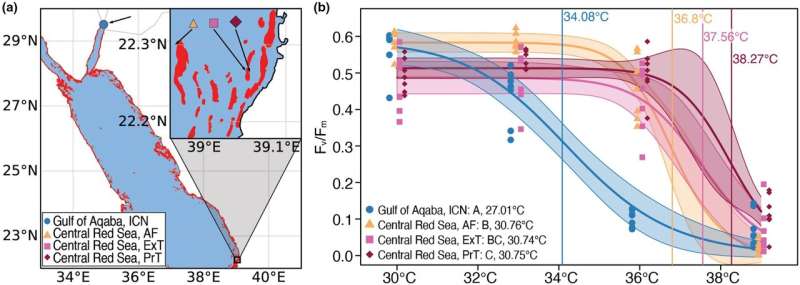Study sites and temperature tolerance thresholds of corals from the northern and central Red Sea. (a) Map of Red Sea sites, reefs are shown in red. Seven coral colonies of S. pistillata from each of one site in the Gulf of Aqaba (ICN), northern Red Sea, and three central Red Sea sites near each other (AF, ExT, PrT) were collected and examined for heat stress response patterns. (b) Photosynthetic efficiency (Fv/Fm) over temperature curves and determined ED50 thermal tolerance thresholds as a proxy for coral bleaching susceptibility (sensu Evensen et al., 2021) of corals from the ICN, AF, ExT, PrT reef sites. ED50 thermal tolerance thresholds are denoted as vertical bars with temperature values at the top of the respective bar in the respective site color. Solid lines in each curve reflect the mean three parameter log-logistic model fit for each population (n = 7 colonies) with 95% confidence intervals represented by the shaded areas. Statistical differences among sites are indicated by letters in the panel legend with site-specific MMM temperatures denoted thereafter. Symbols denote measurements from individual samples. Blue circles, coral samples from the Gulf of Aqaba ICN site; yellow triangles, coral samples from the central Red Sea AF site; pink squares, coral samples from the Central Red Sea ExT site; dark red diamonds, corals from the Central Red Sea PrT site. Credit: DOI: 10.1111/mec.16064
Thermally tolerant corals have different mechanisms for responding to heat stress. This is the conclusion of a current study by an international team of researchers including the Konstanz biologist Professor Christian Voolstra that was published in Molecular Ecology. The team examined responses to heat stress in the smooth cauliflower coral (Stylophora pistillata) in the Red Sea by combining the Coral Bleaching Automated Stress System (CBASS) – a mobile rapid heat stress test—with molecular analyses, in order to identify different types of thermal tolerance. The procedure is to be used worldwide, and the respective results could help provide corals with more targeted protection from the effects of climate change.
Death of corals worldwide caused by warming oceans
As a result of climate change, corals all over the world are currently dying. Within just a few decades, the global coral population has dropped by half, and, due to their locally adapted thermal tolerance, many corals are poorly prepared to respond to further increases in ocean temperatures. Some corals, however, are more adept at managing heat stress than others.
In order to elucidate the factors that contribute to higher thermal tolerance in corals, Voolstra and his colleagues introduced a new mobile testing system last year—the Coral Bleaching Automated Stress System (CBASS). The system makes it possible to quickly identify corals that are particularly resilient. "This test procedure is a small revolution for me, because it allows researchers and conservationists alike to assess coral resilience anywhere on Earth and to find out how endangered each coral reef is, without the need for costly and sophisticated tech", Voolstra described the CBASS system in a previous article.
Different thermal tolerance mechanisms
In the current study, the research team used the testing system to evaluate the thermal tolerance of the smooth cauliflower coral in different regions of the Red Sea. The results show that corals from the Gulf of Aqaba, the most northeastern arm of the Red Sea, demonstrate a remarkable thermal tolerance—up to about 7°C above the respective maximum monthly average for the warmest summer month—just like their peers from the central part of the Red Sea. However, the absolute thermal tolerance of smooth cauliflower corals from the central part of the Red Sea is up to 3°C higher than for the same species in the Gulf of Aqaba, which could suggest that different tolerance mechanisms are at work.
In order to investigate this possibility, the research team conducted molecular analyses to elucidate mechanisms of thermal tolerance in corals from the different locations. Genetic examinations showed that smooth cauliflower corals from the Gulf of Aqaba respond to heat stress with a strongly altered gene expression—for example the increased production of certain proteins. Parallel to this, the composition of the coral-associated bacterial communities changed. By comparison, corals from the central part of the Red Sea did not exhibit any of these changes when exposed to heat stress.
The molecular results support the idea that smooth cauliflower corals have different thermal tolerance mechanisms. "We interpret the response of the corals from the Gulf of Aqaba as that of a "resilient" population that directly and proportionally reacts to increases in temperature. By contrast, the more static expression of genes of the corals from the central part of the Red Sea indicates a fixed reaction norm, irrespective of the heat stress applied, which provides "resistance" to high water temperatures, but at the cost of the ability to flexibly respond to further increases in temperatures", says Voolstra.
Toolbox of methods for protecting coral reefs worldwide
At the moment, it is unclear which of these tolerance mechanisms protects corals better from the global increase in ocean temperatures caused by climate change. The fact that "resilient" and "resistant" tolerance mechanisms can be distinguished using molecular methods could be of great importance for the conservation prioritization of existing coral reefs or for restoration approaches that could use heat-tolerant corals for sexual propagation.
For this reason, the research team is making plans to employ the methodological approach used successfully in the Red Sea study around the world. "Our study shows the tremendous value of an integrative, combined approach: using the CBASS system for the standardized identification of thermal tolerance in corals with subsequent follow-up molecular analyses to identify the underlying tolerance mechanisms and marker genes", concludes Voolstra.
More information: Christian R. Voolstra et al, Contrasting heat stress response patterns of coral holobionts across the Red Sea suggest distinct mechanisms of thermal tolerance, Molecular Ecology (2021). DOI: 10.1111/mec.16064
Journal information: Molecular Ecology
Provided by University of Konstanz
























